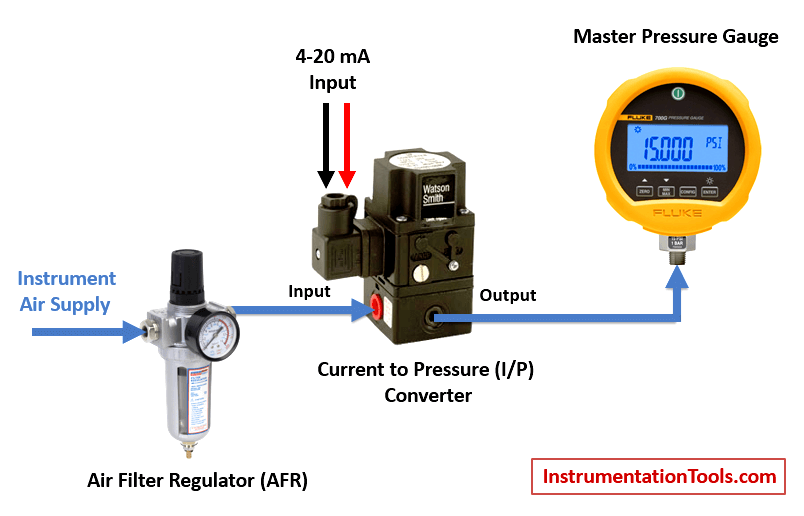A “current to pressure” converter (I/P) converts an analog signal\ (4 to 20 mA) to a proportional linear pneumatic output (3 to 15 psig).
Its purpose is to translate the analog output from a control system into a precise, repeatable pressure value to control pneumatic actuators/operators, pneumatic valves, dampers, vanes, etc.
Principle :
Its force balance principle is a coil suspended in a magnetic field on a flexible mount.
At the lower end of the coil is a flapper valve that operates against a precision ground nozzle to create a backpressure on the servo diaphragm of a booster relay.
The input current flows in the coil and produces a force between the coil and the flapper valve, which controls the servo pressure and the output pressure.
Also Read : Current to Pressure (I/P) Converter Theory
Calibration :
Required Apparatus:
1. Air Filter Regulator
2. I/P Converter
3. Master Pressure gauge (For Measurement of I/P Output pressure)
4. mA Source (to feed mA to I/P Converter)
Calibration Setup :

Calibration Procedure :
After calibration following to be done:
Learn the example of flip-flop PLC program for lamps application using the ladder logic to…
In this article, you will learn the STAR DELTA programming using PLC controller to start…
Lube oil consoles of rotary equipment packages in industrial process plants are usually equipped with…
Rotating equipment packages such as pumps, compressors, turbines need the lube oil consoles for their…
This article explains how to blink lights in ladder logic with a detailed explanation video…
In this article, a simple example will teach you the conversion from Boolean algebra to…
View Comments
Very clear and simple explanation, perfect, thank you
I don't understand why 4mA corresponds to 3 psi?Could you help me?!
same reason why you don't use 0mA. if the pressure drops below 3PSI, the line is probably disconnected of you have a bad leak.
3psi is the minimum, below that you have a problem.
Those are the standard lower limits of calibration for current and pressure respectively in instrumentation. Same way the upper limits are 20mA and 15psig. So as the topic is trying to explain conversion from one signal to the other, there is need to understand how each corresponds to the other